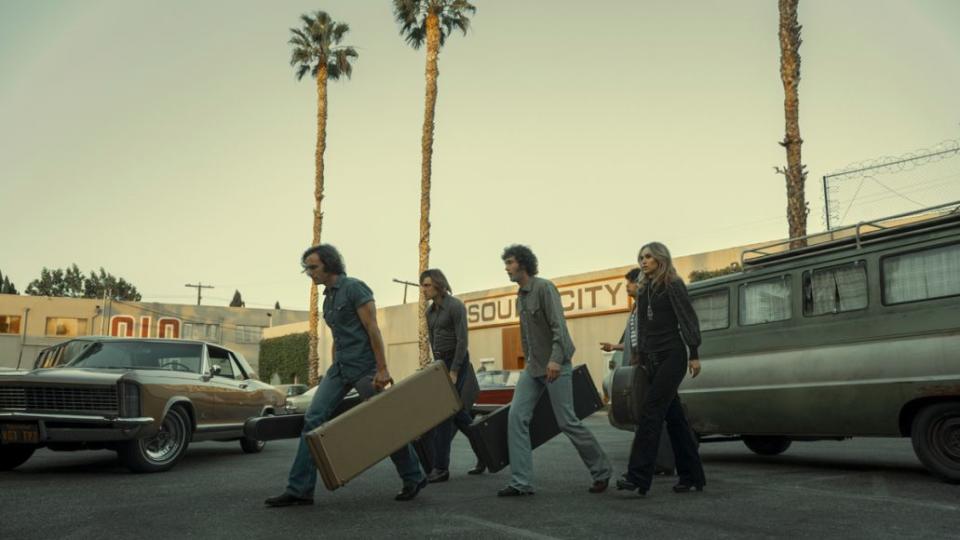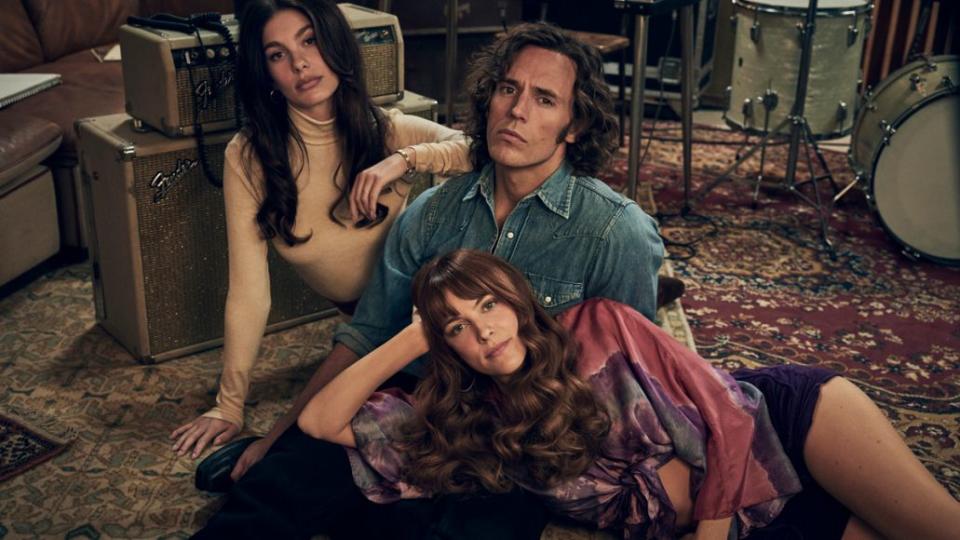Daisy Jones & the Six Jumps Off the Page, But Doesn’t Quite Stick the Landing: Review
- Oops!Something went wrong.Please try again later.
The post Daisy Jones & the Six Jumps Off the Page, But Doesn’t Quite Stick the Landing: Review appeared first on Consequence.
The Pitch: There are so many reasons Fleetwood Mac have remained one of the bands people talk about to this day — great music is one of them, of course, but the addictive allure of personal drama and behind-the-scenes tension is certainly another. Daisy Jones & the Six, the 2019 novel by Taylor Jenkins Reid, explores a similar phenomenon. What could cause a band to dissolve at the very top of their game?
This Amazon adaptation of the book presents the following introduction as the cast gets seated for talking head-style interviews: “On October 4th, 1977, Daisy Jones & the Six performed to a sold-out crowd at Soldier Field in Chicago, Illinois. It would be their final performance.” We’re then introduced to Daisy (Riley Keough, a powerhouse), Billy Dunne (Sam Claflin), and the members of the Six — Billy’s brother, Graham (a very lovable Will Harrison), Karen (Suki Waterhouse), Eddie (Josh Whitehouse), and Warren (a truly delightful Sebastian Chacon).
The ten-episode saga takes us through the band’s humble origins, which run in parallel to Daisy’s early days pursuing music, chronicling the connection, quick rise, and even faster fall of what is presented to us as “the biggest band in the world.”
Look At Us Now: The adaptation, produced by Reese Witherspoon‘s Hello Sunshine, excels in its truly inspired casting. From the jump, the sparks that fly between Keough (yes, the real-life granddaughter of Elvis Presley) and Claflin as Daisy and Billy are enough to keep any viewer engaged, whether or not they’re familiar with the source material. Musician and actress Suki Waterhouse is a joy as Karen, seeming as comfortable onstage behind the keyboard as she is moving through Karen’s more emotional beats.
The band’s backdrop is filled out by Timothy Olyphant as sun-dried road manager Rod and Tom Wright as storied producer Teddy Price, along with disco singer Simone Jackson (relative newcomer Nabiyah Be, who carries the expanded story for the “best friend of Daisy” character with believability and grace).
Then, there’s Camila Morrone, unbelievably beautiful and unbelievably sympathetic as Camila, rockstar Billy Dunne’s young, forgiving, dependable other half. Some of the best tweaks from the book are in Camila’s characterization, who was already more than the dutiful housewife in the book, but here serves an even bigger role in the band’s early momentum.

Daisy Jones and the Six (Prime Video)
We Can Make a Good Thing Bad: The cast truly shines, but great chemistry does not necessarily equate to a great adaptation overall. Some of the changes from the text undercut the intensity of the story — removing Daisy’s “it girl” era entirely, instead positioning her as a struggling singer working in a diner and waiting for her big break, removes some of what makes her character so interesting. Daisy is the first to describe herself as selfish and messy; the people around her have plenty of anecdotes alluding to times she floated through life, but no one seems to resent her for it. Framing Daisy instead as just another girl with a dream makes the story far closer to one we’ve seen many times before.
Similarly, some of the other, larger changes were presented by series co-creator Scott Neustadter as reflective of the “unreliable narrator” concept clearly laid out in the book — readers are led to believe that the individual accounts of events, which cut back and forth between perspectives, are as the people involved choose to remember them, and not necessarily how things actually happened.
However, the way the show is structured never leads the viewer to believe that anything we are seeing is less than fact. We never see the same events presented from multitple different perspectives, nor do we experience anything in a way that would indicate a timeline is muddied, edited, or incomplete. Everything we see on screen is presented simply as what happened, making Neustadter’s defense of the changes feel a bit hollow.
Not to keep returning to Reid’s text, but there’s a thrill in the quick pace between perspectives, and often plenty of room for humor. The book is rich in dramatic irony for the reader, who is always able to piece things together before the individuals on the page, and this doesn’t translate to the screen. Certain dynamics are heightened and physicalized, others are cut out entirely, and many of the changes, unfortunately, are to the detriment of the story.
The creators and writers seemed especially to want to soften Daisy in particular, but Keough comes alive when the hard edges and ugly sides of the title character are brought out into the light. It feels like a shame that we don’t get to see more of it.

Daisy Jones and the Six (Prime Video)
Regret Me, Regret You: It’s understandable that the show would want to utilize these great actors as much as possible, but the idea that we are seeing these characters twenty years down the road from the events depicted is laughable — hair and makeup indicates a passage of five years at the absolute maximum, and only Claflin looks on the way to becoming a washed-up former rock star. More commitment to aging these characters, or, better yet, swapping them with actors actually closer to their 40s or 50s, would have gone a long way.
Similarly, the 1970s styling looks fantastic on these characters, but costuming often feels more like a vintage-inspired aesthetic than actual costume pieces. “Old footage” of the band onstage looks like it was run through an Instagram filter. Venues for tours visually blend together, which could potentially be an intentional reflection of the way the characters feel on the road, but Studio 8H at what is supposed to be a taping of Saturday Night Live is glaringly inauthentic.
I Can See Us: Thankfully, the music is solid enough for us to believe that this band could take off in such a capacity. “Look At Us Now (Honeycomb),” with its dramatic build, is far and away the best of the bunch, but Keough’s raspy vocals shine on “Regret Me,” too.
The performers we see here are doing the singing and playing depicted, while quite a few all-stars contributed to the soundtrack behind the scenes — “Look At Us Now (Honeycomb)” was co-written by Marcus Mumford and Jonathan Rice, and Phoebe Bridgers, Jackson Browne, and Taylor Goldsmith also appear in song credits elsewhere. While not A Star Is Born levels of real-life playability, there are some gems in the soundtrack, a major win for a story that relies on the music to ultimately work.
The Verdict: There’s a chance the folks who enjoy the adaptation of Daisy Jones & the Six the most will be the ones who are experiencing the story for the first time. While book-to-screen adaptations certainly don’t have to follow story beats to a tee in order to be successful, some of the more drastic changes here don’t feel in service of the central narrative.
Daisy Jones & the Six feels like it’s hurtling towards an explosion; it’s a shame it ends with more of a fizzle. Even so, by the time the last notes ring out, there’s a strong chance the viewer will be brushing away tears — this writer still found herself doing so.
Where to Watch: The first three episodes of Daisy Jones & the Six will be streaming on Amazon on Friday, March 2nd. New episodes will roll out weekly on Fridays subsequently.
Trailer:
Daisy Jones & the Six Jumps Off the Page, But Doesn’t Quite Stick the Landing: Review
Mary Siroky
Popular Posts

